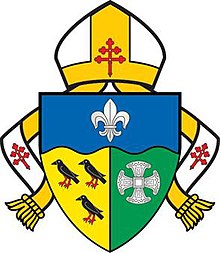Roman Catholic Archdiocese of Southwark
|
Archdiocese of Southwark Archidioecesis Southvarcensis |
|
|---|---|

Coat of arms of the Archdiocese of Southwark
|
|
| Location | |
| Country | England |
| Territory | The London boroughs south of the Thames, the county of Kent and the Medway Unitary Authority |
| Ecclesiastical province | Southwark |
| Metropolitan | Southwark |
| Deaneries | 20 |
| Statistics | |
| Area | 3,000 km2 (1,200 sq mi) |
| Population - Total - Catholics |
(as of 2010) 4,444,065 383,265 (8.6%) |
| Parishes | 181 |
| Information | |
| Denomination | Roman Catholic |
| Rite | Latin Rite |
| Established | 29 September 1850 |
| Cathedral | St George's Cathedral, Southwark |
| Secular priests | 274 |
| Current leadership | |
| Pope | Francis |
| Metropolitan Archbishop | Peter Smith |
| Auxiliary Bishops | |
| Emeritus Bishops |
|
| Map | |
 Dioceses of the Province of Southwark. The Archdiocese of Southwark is the easternmost |
|
| Website | |
| rcsouthwark.co.uk | |
The Roman Catholic Archdiocese of Southwark (Br [ˈsʌðɨk]) is a Latin Church Roman Catholic archdiocese in England. The archepiscopal see is headed by the Archbishop of Southwark. The archdiocese is part of the Metropolitan Province of Southwark, which covers the South of England. The cathedral church is St George's Cathedral, Southwark.
The archdiocese covers the London boroughs south of the Thames, the county of Kent and the Medway Unitary Authority.
The diocese is divided into three pastoral areas and 20 deaneries, each of which contain a number of parishes:
Kent Pastoral Area: 50 parishes
South East Pastoral Area: 66 parishes
South West Pastoral Area: 64 parishes
Southwark was one of the dioceses established at the restoration of Catholic hierarchical structures in 1851 by Pope Pius IX. The areas which now comprise the Diocese of Portsmouth and the Diocese of Arundel and Brighton subsequently separated.
The Papists Act of 1778 brought a certain limited freedom to those of the faith. Priests no longer moved in fear of imprisonment. Roman Catholics could run their own schools and could once more acquire property. In protest against the act, Lord George Gordon, on 2 June 1780, gathered a large crowd in St George's Fields to march on Westminster. Refused a hearing, they became violent and so began a week of burning, plundering and killing in which many Roman Catholic chapels and houses were destroyed. There is a legend that the high altar of the cathedral stands on the spot where the march began.
...
Wikipedia
